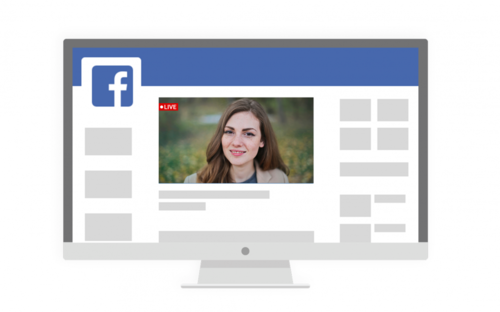by Farraz Khan
It’s a basic question: Why live video?
When there are so many content types — normal video, blog, image, infographics, podcasts, white papers, e-books, webinars, and so on — why should a content marketer commit resources to live streaming, a comparatively new format?
The short answer: Live video lets you do more with your content. A lot more.
The example of Facebook Live and, more recently, LinkedIn Live — in addition to brands live streaming on their own platforms — proves that live video is far from a fad or gimmick. Instead, it’s a uniquely potent format for all levels of the marketing funnel.
Here’s why live is indispensable for a marketer:
1. Results: Live is the most powerful format online.
Simply put, livestreaming works.
It delivers significantly higher viewership and engagement on digital platforms than the next-highest format (non-live video). On Facebook, for instance, live videos generate 10x the engagement and 3x the watch time of normal videos. Why?
-
Urgency: When most online content is on-demand, there is something uniquely compelling about an immediate, in-the-moment experience, which live allows. The transient nature of live activates a sense of FOMO in audiences, creates exclusivity, and gives remote viewers a feeling of access — all of which drive participation, especially when coupled with moment-in-time events like conferences, product reveals, etc.
-
Length: With live video, there is plainly more content to interact with. As real-time content, live streams tend towards greater length. So while non-live video grows ever shorter (e.g., 6-second bumper ads), live video can run for upwards of 15, 30, even 60 minutes. Sheer length — the amount of content — creates more opportunities to engage.
-
Transparency: Live streams feel organic, unmediated, and real. As consumers grow savvier and more skeptical of communications from brands, live video is a format that connotes authenticity and lack of artifice. It is of the zeitgeist, applying consumer-behavior insights we’ve learned from the popularity of consumer apps like Instagram Stories and Snapchat to B2B and B2C communications.
-
Platform algorithms: By itself, live video delivers high viewership and engagement. But those results are turbocharged by algorithms on social platforms (e.g., Facebook), which favor live content — showing them on more feeds, placing them higher on feeds, drawing in audience via push notifications, etc. — ensuring even greater exposure. What’s the incentive for social platforms? To surface content that is already proven to win engagement.
2. Real-time interaction: Live more effectively drives engagement and action
Live video also transforms the nature of engagement.
Whether on social platforms like LinkedIn or Facebook, or on brand platforms like a company’s web pages or apps, live streaming enables organizations to turn viewers of content into active participants and for organizations to respond to their audience members live — turning traditional one-way communication into a two-way conversation.
This produces a powerful source of feedback for an organization, while also deepening the brand-customer relationship and increasing customer loyalty simply by giving audience access and showing them that they are heard.
But, even more, live video is a powerful way to drive action by using broadcasts as vehicles for conversion — via contests, promos, and urgent calls-to-action.
3. Authenticity: Live lets you humanize your brand
As a real-time format, live video feels unmediated, uncontrived, and honest (unlike slickly edited video). By its very nature, it also favors human subjects speaking into camera in a direct, unscripted way.
For organizations, that means opportunities to highlight the humans behind a brand, from leadership, to partners, to everyday employees. Allowing the people at an organization to tell an organization’s story — and to do so in a way that feels unvarnished and real (pauses, “ums,” and all) — helps build goodwill, credibility, and brand affinity among consumers or would-be consumers.
This is especially important when — as mentioned above — consumers are more keenly attuned to artifice in brand communications.
4. Ease: Live doesn’t need the high production value of traditional video
In line with the authenticity of live video, is the live-video aesthetic.
Live and live-like content benefits from a rawer, stripped-down, more organic look — which underscores the authenticity of a piece of content. Simple one- or two-camera setups with simple lights and natural backgrounds are often sufficient. (You can even use a smartphone camera.)
Because the production demands are lower, live streaming represents an easy, efficient way to generate video content.
It’s even easier with Socialive, a video creation platform with a foundation in live. Socialive makes it easy to create live content that’s still on-brand — combining the simple aesthetic of live video with just enough branded elements to maintain brand equity.
With Socialive, you can bring in multiple live cameras, mix with pre-recorded video clips, quickly add on-screen graphics, switch layouts to split-screens, easily bring in guests from remote locations — and do it all in real time, like you’re producing a live TV broadcast.
5. Big-rock content: Live is raw content that can be repurposed
Live video has value even after it’s no longer live.
As a typically long-form format, live video yields a lot of video content that can be cut-down, segmented, repackaged, etc., to generate fresh organic and paid content.
Here’s how it works.
For marketers, live streaming enables efficient content creation — both video and non-video.
Fundamentally, live video is a format that connects the dots between content and conversion.
Not only does it expand the audience for a message, it also boasts the characteristics and contains the levers that reliably turn passive viewership into direct, real-time action.
For digital and content marketers today, then, live streaming is a highly relevant, highly impactful way to communicate, engage, and activate a universe of consumers.

